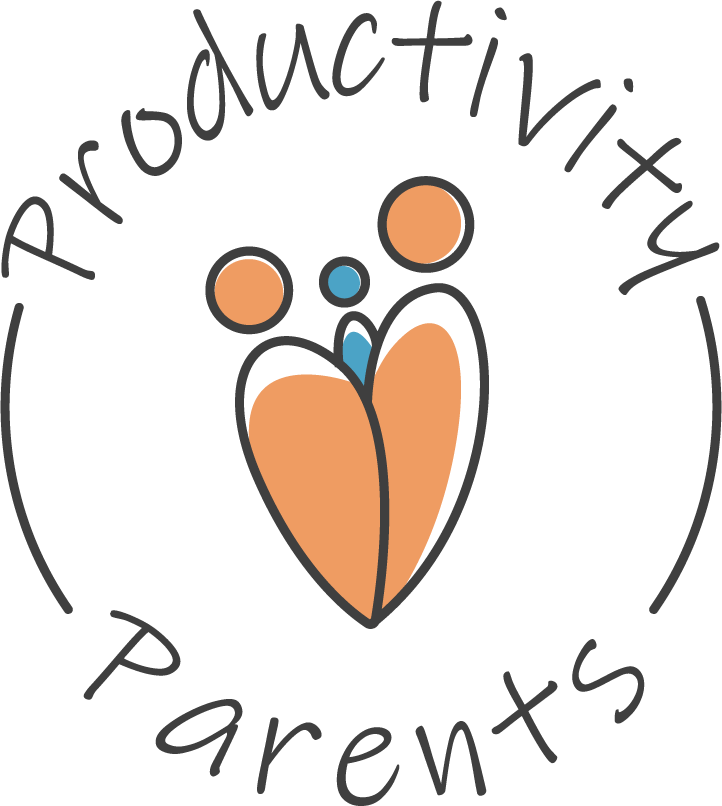In today’s digital age, technology can be a powerful ally in helping families achieve their goals together. By creating a family tech plan that everyone contributes to, you can transform devices from potential distractions into tools for success and connection. I’ve found that when families collaborate on establishing tech guidelines, they’re more likely to stick with their shared objectives.

The most effective family goal-setting strategies involve creating specific and measurable targets that everyone can work toward while maintaining healthy digital boundaries. Experts suggest limiting screen time to 1-2 hours daily for children and teens, ensuring technology enhances rather than dominates family life.
Before implementing new tech tools, I recommend checking in with yourself or your partner about your values regarding family time and technology usage. This reflection helps create meaningful guidelines that align with your family’s unique needs and priorities rather than adopting a one-size-fits-all approach.
Key Takeaways
- Technology becomes most beneficial when families collaboratively create specific, measurable goals with appropriate digital boundaries.
- Regular check-ins about family values and technology usage help maintain balance and prevent devices from becoming distractions.
- Celebrating progress together while modeling positive tech habits strengthens family connections and increases goal achievement.
Benefits of Using Technology for Family Goal Setting
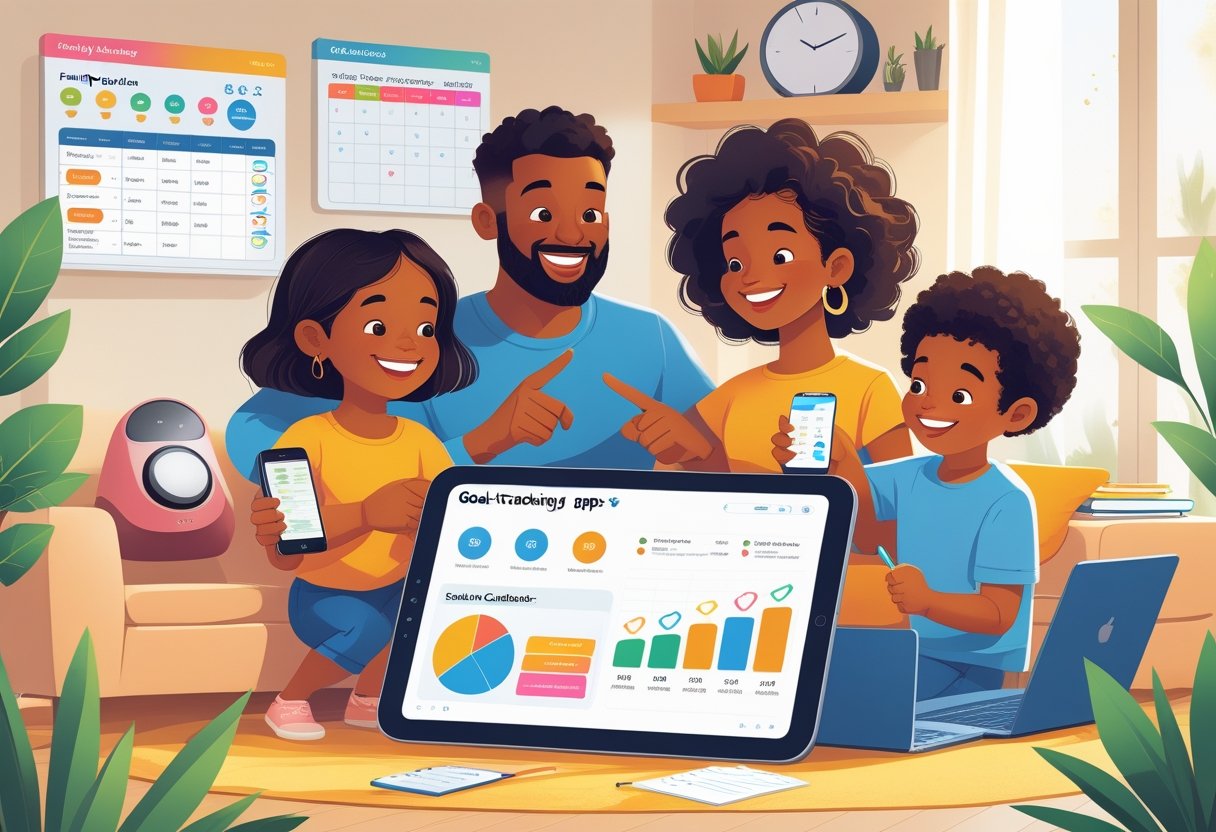
Technology provides powerful tools that transform how families approach and accomplish their shared objectives. Digital solutions create structure, visibility, and engagement that traditional goal-setting methods often lack.
Enhancing Accountability and Motivation
Digital platforms offer built-in accountability features that significantly improve follow-through on family commitments. Apps can send timely reminders about upcoming deadlines and daily tasks, preventing goals from being forgotten amidst busy schedules.
Many goal-tracking apps incorporate gamification elements like badges, streaks, and point systems that make the process enjoyable for all family members. These features are particularly effective with children who respond well to the reward mechanisms.
Setting goals for technology use can create positive perspectives on what might otherwise be viewed as restrictions. I’ve found that when families celebrate achievements together through digital platforms, it creates positive reinforcement cycles.
Research shows that public commitment increases follow-through rates by up to 65%. When family members share goals on connected apps, this accountability effect multiplies.
Fostering Collaboration and Communication
Technology breaks down barriers to family collaboration through shared digital spaces. Cloud-based tools allow family members to contribute ideas, make adjustments, and provide encouragement regardless of physical location or schedules.
Digital family planning tools enable real-time updates that keep everyone informed and involved. This constant connection maintains momentum even during busy periods when in-person check-ins are difficult.
Virtual family meetings through video platforms ensure that distance or conflicting schedules don’t prevent goal discussions. I’ve observed how these tools are especially valuable for families with older children living away from home.
Collaborative apps provide neutral ground for discussing sensitive goals, allowing shy family members to contribute ideas they might not voice in person. This inclusive approach ensures everyone feels ownership of family objectives.
Making Progress Visible and Trackable
Digital tracking tools transform abstract goals into concrete, measurable achievements. Visual dashboards and progress bars provide immediate feedback that motivates continued effort and celebrates incremental success.
Data visualization helps families identify patterns in their progress, highlighting both successful strategies and potential obstacles. I’ve seen how this analytical capability allows for timely adjustments to approaches that aren’t working.
Goal-tracking applications offer sophisticated metrics that traditional methods can’t match. Features like habit streaks, completion percentages, and historical comparisons provide nuanced understanding of progress.
Automated data collection removes the tedium of manual tracking, increasing the likelihood that family members will maintain their monitoring efforts. This persistence in tracking is often the difference between abandoned and achieved goals.
Digital archives preserve the family’s goal history, creating a meaningful record of growth and achievement that can inspire future efforts.
Selecting Goal-Oriented Tech Tools
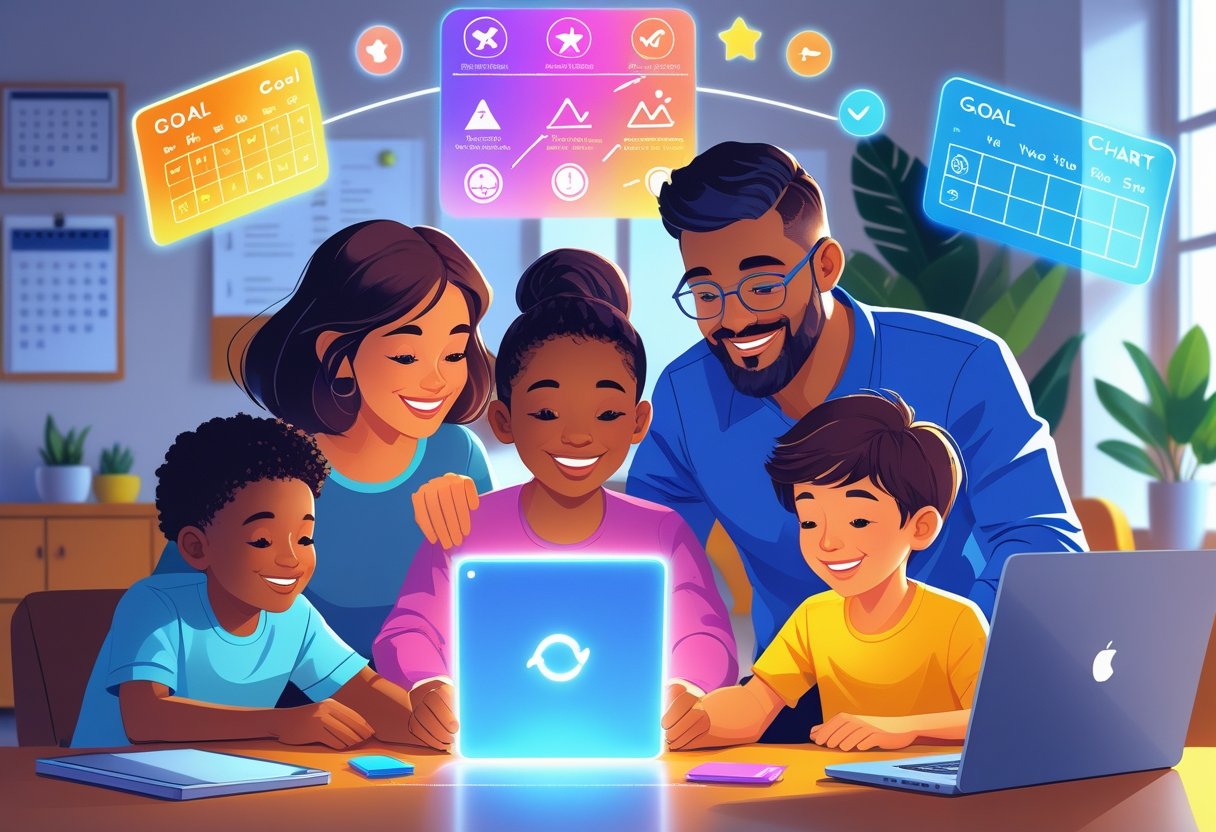
Finding the right technology solutions can transform how families work together to achieve their goals. The digital landscape offers numerous tools designed specifically to help families track progress, coordinate schedules, and provide timely reminders for staying on course.
Family-Friendly Goal Tracking Apps
Several apps excel at helping families track and achieve goals together. Cozi stands out with its family-oriented interface that allows each member to set personal objectives while contributing to shared family goals. I’ve found that TickTick and Habitica offer gamified approaches that particularly engage children and teens.
For younger families, GoalSetter teaches financial literacy while tracking saving goals. Its age-appropriate features help children understand goal-setting fundamentals.
When selecting an app, consider these key factors:
- Ease of use for all family members
- Visual progress indicators
- Positive reinforcement features
- Cross-platform availability
Most effective family goal apps include customizable rewards systems that can be tailored to your family’s values and preferences.
Shared Calendars and Scheduling Platforms
Google Calendar remains my top recommendation for families due to its color-coding features and seamless sharing capabilities. Each family member can maintain personal calendars while contributing to a master family schedule.
Microsoft Family Calendar integrates well with Windows devices and offers excellent permission controls for parents. For Apple-centric households, the built-in Family Sharing features provide robust scheduling tools.
Consider these scheduling platform features:
- Automated reminders
- Location-based alerts
- Permission levels for different family members
- Integration with other productivity tools
I recommend setting up recurring calendar events for goal check-ins. This creates accountability and maintains momentum toward family objectives.
Smart Devices for Reminders and Updates
Smart speakers like Amazon Echo and Google Nest serve as central hubs for family goal management. I use voice commands to check on progress, set timers for tasks, and broadcast reminders to everyone at home.
Smart displays enhance this functionality by providing visual feedback. The Echo Show and Nest Hub allow families to view shared calendars, goal trackers, and to-do lists at a glance.
For younger children, dedicated devices like the Octopus Watch teach responsibility through icon-based reminders and rewards.
Consider placing smart devices in common areas where the whole family gathers. This placement ensures important reminders reach everyone and creates natural opportunities for goal discussions during daily routines.
Establishing Family Goals with Technology

Technology offers powerful tools for families to set meaningful goals together and track their progress. Digital platforms create opportunities for engagement that traditional methods often miss, especially with tech-savvy children and teenagers.
Facilitating Collaborative Goal Discussions
Family goal-setting starts with inclusive conversations where everyone feels heard. I recommend using digital whiteboards like Miro or Jamboard for brainstorming sessions that engage all family members.
These platforms allow everyone to contribute ideas simultaneously using different devices, which helps balance participation between outspoken and quieter family members.
Consider scheduling a monthly “Family Goals Night” using calendar apps with automated reminders. During these sessions, use collaborative apps to categorize goals into areas like:
- Health & Fitness: Daily step challenges, meal planning
- Education: Reading goals, learning new skills
- Family Time: Weekly activities, vacation planning
- Home Projects: Chores, renovations, organization
Tools like Mentimeter allow for anonymous voting on priorities, helping families democratically decide which goals deserve immediate attention.
Digitizing Goal Documentation
Once goals are established, digital documentation ensures they remain visible and actionable. I’ve found that creating a shared digital family hub serves as the foundation for successful goal tracking.
Consider using platforms like Notion, Trello, or even Google Docs to create a centralized family dashboard. These tools allow you to transform vague aspirations into structured plans with deadlines, responsibilities, and progress indicators.
Visual elements are crucial for maintaining engagement. Create customized progress bars, countdown timers, or digital sticker charts that provide satisfying visual feedback.
For younger children, apps like GoHenry or BusyKid combine financial literacy with goal-setting by connecting chores and responsibilities to rewards. Teenagers often respond well to goal-tracking apps with social components like Strides or Habitica.
Remember to enable notifications that celebrate milestones rather than just reminding about tasks. This positive reinforcement builds momentum toward achieving family objectives.
Creating Action Plans and Reminders
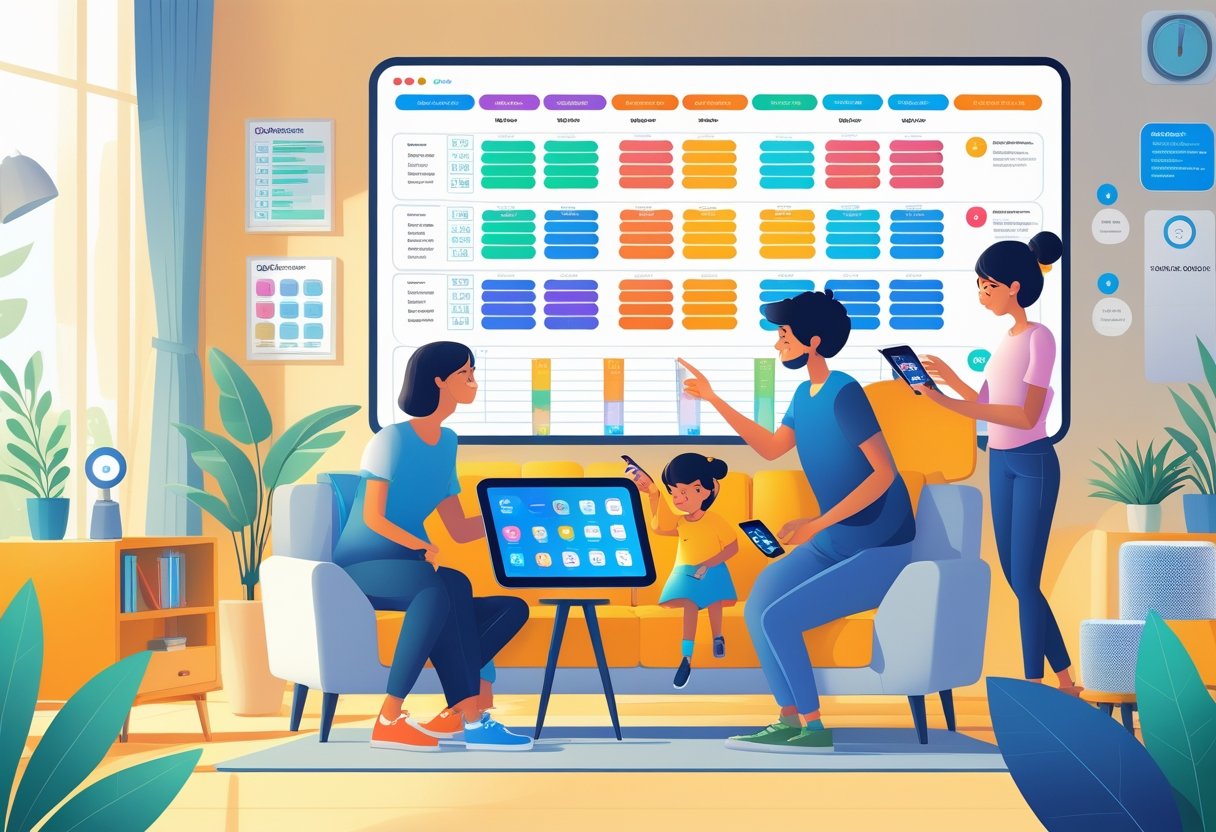
Turning family goals into achievable tasks requires organization and accountability tools. Modern technology offers practical solutions for tracking responsibilities and providing timely reminders to keep everyone on target.
Assigning Tasks with Apps
Family task management apps create structure for your goals by breaking them down into actionable steps. Apps like Structured or TimeBloc help create time blocks for your habits and routines, making it easier to visualize when and how goals will be accomplished.
I recommend using apps with shared family interfaces where each member can see their responsibilities. Consider color-coding tasks by family member or priority level to improve clarity at a glance.
For younger children, I find that visual task boards with digital stickers or achievement badges provide motivation. Many apps allow you to assign point values to completed tasks, turning goal achievement into a friendly family competition.
Setting Custom Notifications
Strategic reminders transform good intentions into consistent action. I suggest creating personalized notifications that align with each family member’s schedule and communication preferences.
When developing your family’s tech plan, include a discussion about the best times for reminders. Morning people might benefit from early check-ins, while others may need evening prompts.
Customize notification language to be encouraging rather than demanding. Messages like “Time for our family reading session!” feel more motivating than “Reading time now.”
I’ve found that location-based reminders work exceptionally well for family goals. Set your phone to remind you about exercise when you’re near the park, or about meal planning when you approach the grocery store.
Tracking Progress and Adapting Strategies
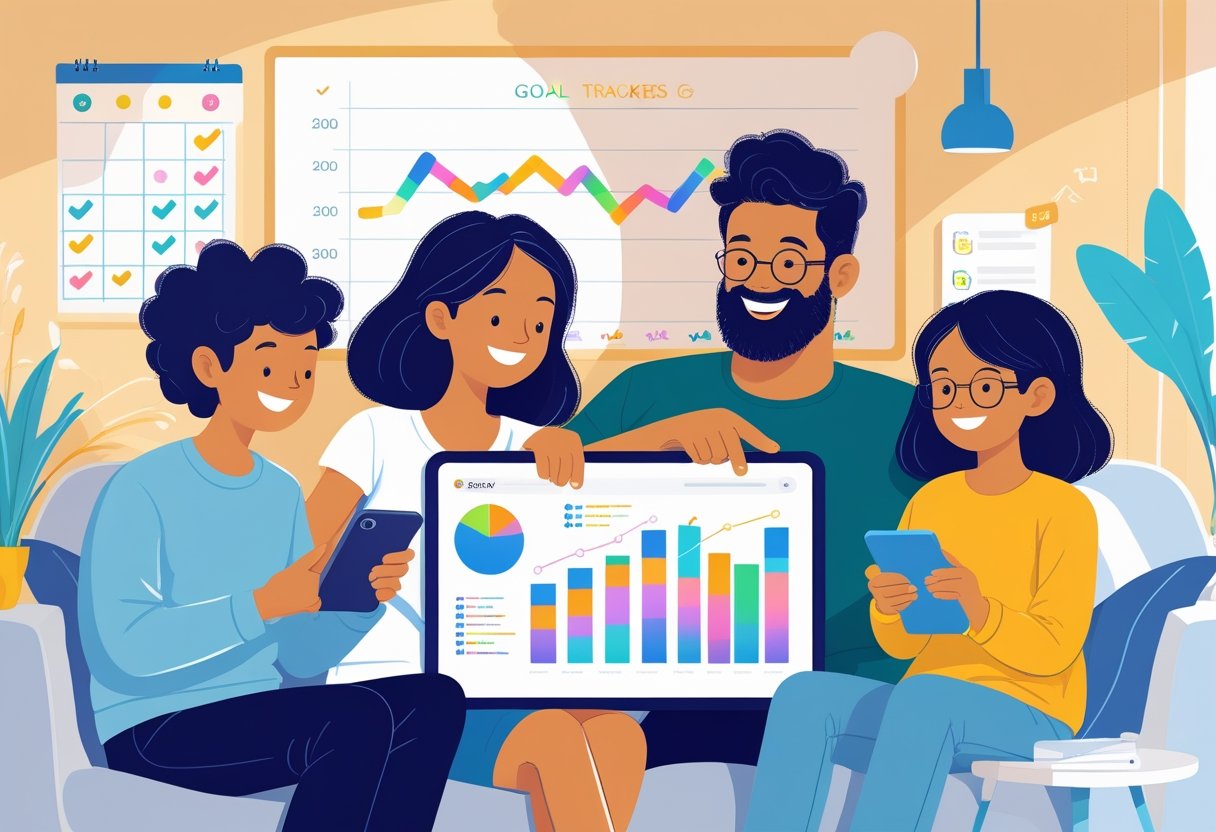
Effective family goal tracking combines visual indicators with data-driven insights to maintain momentum and make necessary adjustments along the way.
Visualizing Milestones and Achievements
Creating visual representations of your family’s progress makes goals tangible and motivating. I recommend using a family goal board in a common area where everyone can see daily progress.
Digital tools like progress bars and achievement badges in apps provide instant gratification when milestones are reached. For younger children, sticker charts that sync with digital platforms combine physical and virtual tracking.
Time-lapse photos or video journals documenting progress work well for physical goals like home improvement projects or fitness challenges. These visual records become powerful motivators during challenging periods.
Consider color-coding family goals by category (health, education, finance) to quickly identify areas needing attention. Celebrate small wins visibly – digital confetti animations or physical gold stars maintain enthusiasm and reinforce positive behaviors.
Leveraging Analytics and Reports
Many activity tracking apps provide robust analytics that help identify patterns in your family’s progress. I look for apps offering weekly summary reports that highlight achievements and suggest areas for improvement.
Set up automated alerts when family members reach certain thresholds or miss check-ins for several days. These gentle reminders keep everyone accountable without nagging.
Data visualization tools that transform numbers into graphs or charts make complex information accessible for all family ages. Look for apps that offer customizable dashboards showing metrics most relevant to your specific goals.
Regular weekly reflection sessions using collected data help identify which strategies are working and which need adjustment. This approach teaches children valuable critical thinking skills while keeping goals adaptive to changing circumstances.
Encouraging Accountability and Celebrating Success
Tracking progress and recognizing achievements creates powerful motivation for families pursuing shared goals. The right combination of regular check-ins and thoughtful rewards can transform your family’s commitment to objectives while strengthening bonds.
Setting Up Family Check-Ins
Family meetings provide structure for goal accountability. I recommend scheduling weekly 15-minute check-ins on Sunday evenings to review progress and address challenges. Research shows people who document their goals are 33 percent more successful in achieving them.
Create a shared digital calendar with reminders for these meetings. Google Calendar works well as it syncs across devices and sends notifications. During check-ins, use apps like Trello or Asana to visualize progress with simple boards showing:
- Goals in progress
- Completed milestones
- Upcoming targets
- Obstacles needing attention
Each family member should get equal time to speak about their individual contributions to family goals. This fosters both personal responsibility and team spirit.
Using Tech for Reward Systems
Digital reward systems provide immediate positive reinforcement. I find gamification particularly effective for maintaining family motivation. Apps like ClassDojo or GoalForIt allow you to create customized achievement badges and point systems.
Set up different point values for:
- Small daily actions (5 points)
- Weekly milestones (25 points)
- Major achievements (100 points)
Family members can redeem accumulated points for meaningful rewards like choosing a weekend activity or extra screen time. Digital rewards work best when combined with tangible celebrations.
Create a digital “Wall of Fame” using a shared cloud folder where you store photos or videos of milestone celebrations. This visual record reinforces progress and creates lasting positive associations with goal achievement.
Ensuring Healthy Digital Habits
Creating balance and boundaries in our digital lives is essential when using technology to achieve family goals. This involves mindful screen time management and implementing proper security measures to protect everyone’s personal information.
Balancing Screen Time
Setting clear boundaries helps prevent technology from dominating family life. I recommend establishing tech-free zones in your home, such as bedrooms and dining areas, to maintain focus on personal connections.
Communicate early and often with family members about the role of technology in your lives. Ask questions about how digital tools make everyone feel and discuss potential risks together.
Consider implementing these practical strategies:
- Use screen time tracking apps to monitor usage
- Schedule regular digital detox days
- Create a family media plan with clear expectations
- Model healthy tech habits yourself
Remember to periodically revisit and adjust your family tech plan as needs change. Technology evolves rapidly, and your approach should too.
Maintaining Privacy and Data Security
When using apps and platforms to track family goals, protecting personal information must be a priority. I ensure all family accounts have strong, unique passwords and enable two-factor authentication whenever possible.
Review privacy settings on all devices and accounts regularly. This includes:
Device Security:
- Keep operating systems updated
- Use parental controls appropriately
- Install reputable security software
Account Management:
- Limit data sharing permissions
- Use private browsing when appropriate
- Teach children about safe online practices
Consider using a family password manager to maintain security across multiple devices and accounts. I also recommend discussing what information is appropriate to share online, especially when using goal-tracking apps that may collect personal data.
Encourage family members to use technology creatively rather than passively consuming content, which promotes a healthier relationship with digital tools while working toward your goals.
Frequently Asked Questions
Families often have specific questions about using technology to support their collective goals. These FAQs address common concerns about digital tools, communication strategies, and maintaining healthy tech boundaries.
What are effective tech tools for tracking family fitness and health goals?
Several apps make family fitness tracking both fun and effective. Many fitness trackers now offer family accounts where everyone can see each other’s progress and celebrate achievements together.
I recommend apps like Strava for families who enjoy outdoor activities, as it allows members to share routes and cheer each other on. For younger families, gamified options like Fitbit’s family challenges turn step counting into friendly competition.
Smart scales that sync with family accounts can help track progress for health-focused goals. Some families find success with meal planning apps that allow collaborative shopping lists and recipe sharing.
How can family-focused apps encourage positive habits and goal achievement?
Family-focused apps create accountability through shared visibility of progress. When everyone can see each other’s contributions toward a goal, it naturally encourages consistency and follow-through.
Apps with achievement badges or reward systems are particularly effective for younger family members. Many family tech plans include using apps that turn chores or habits into games with point systems.
I’ve seen families successfully use habit tracking apps where everyone checks off daily tasks and celebrates streaks together. This positive reinforcement helps new habits stick more effectively than when attempted individually.
In what ways can technology facilitate better communication about goals within a family?
Shared digital calendars create transparency about everyone’s commitments and deadlines. This visibility helps families align individual schedules with collective goals.
Group messaging platforms dedicated to family goals provide a space for quick check-ins, encouragement, and problem-solving. Many families set up specific channels for different goals—one for fitness, another for academic achievements.
Video calls connect family members across distances for regular goal review sessions. These structured check-ins maintain momentum even when everyone can’t be physically present.
Can you recommend strategies for using technology to manage family schedules and goals?
Digital family calendars with color-coding for each person help visualize how individual activities align with family goals. I suggest setting automated reminders for goal-related activities to keep everyone on track.
Project management apps traditionally used for business can be repurposed for family goal tracking. Apps like Trello or Asana allow families to break down big goals into manageable tasks with clear ownership and deadlines.
Smart home assistants can be programmed to announce daily family goals or provide reminders about shared commitments. This ambient technology keeps goals present without requiring constant screen time.
What role do parental controls play in balancing screen time with family objectives?
Parental controls are valuable tools for ensuring technology serves family goals rather than distracting from them. Experts recommend limiting children and teens to 1-2 hours of recreational screen time daily, preserving time for other goal-oriented activities.
I find that the most effective approach isn’t just restriction but redirection. Controls that block certain apps during homework time or limit gaming until fitness goals are met teach priority management rather than just limiting access.
Setting up tech-free zones or times as part of your family tech plan helps everyone disconnect and focus on in-person activities. This balance ensures technology remains a tool for achievement rather than a constant distraction.
How can educators leverage technology to enhance home-school partnership in goal setting?
Educational apps with parent portals create visibility into academic progress and areas needing support. These platforms allow families to set goals aligned with classroom objectives.
I’ve seen great success when teachers use digital portfolios that allow students to share work samples with parents. This real-time sharing creates opportunities for meaningful conversations about academic growth and goals.
Communication apps connecting teachers with families ensure everyone stays aligned on educational priorities. Regular updates through these platforms help families support school-based goals through complementary activities at home.
